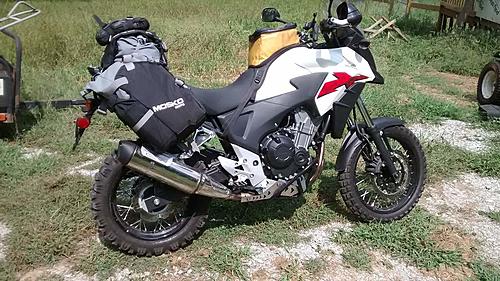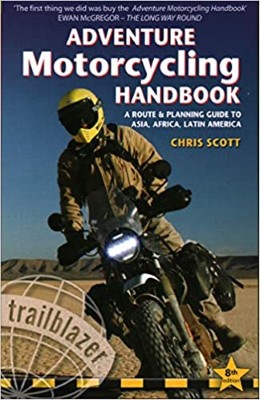 82Likes 82Likes
 |
|

29 Aug 2015
|
 |
Registered Users
Veteran HUBBer
|
|
Join Date: Sep 2007
Location: Lutterworth,Midlands, UK
Posts: 573
|
|
I should have added that I also had a 2008 tenere and loved the bike but being short of leg found it a bit top heavy, I also found the seat shape and width restrictive in that it was too wide and the stepped seat meant I struggled to get my weight over the rear when needed.
I loved the power off road but found it lacking on longer road runs.  with the additions of better suspension components even better fuel economy and lower height this honda makes a good alternative then when you add in a better motor for road work and you have a great all rounder, perfect for the commute, a spot of green lanning and the annual blast to warmer,dustier and rocky climes
Last edited by stuxtttr; 29 Aug 2015 at 13:05.
|

29 Aug 2015
|
 |
R.I.P.
Veteran HUBBer
|
|
Join Date: Aug 2003
Location: california
Posts: 3,821
|
|
Quote:
Originally Posted by JMo (& piglet)

Hi Stu - yes I agree, I've always felt the XT660Z Tenere is the best off-the-shelf adventure bike out there, and with that 700cc twin cylinder engine it would be even better... and they really wouldn't/shouldn't change all that much to be honest - perhaps a simpler/lighter exhaust system and a slightly lower seat height?
As you are probably aware, I have/had a good deal of experience with the 660Z - having bought one of the first ones when it came out in 2008, and certainly the XT was very much one of our benchmark bikes (along with the BMW F700GS) we used when drawing up the specification for the CB500X Adventure kit.
Having just completed a very similar trip on the CB that I did with the XT back in 2008/09, I can honestly say the CB (with the Rally-Raid kit fitted of course) was just as capable if not moreso on the Trans-Am Trail... and appreciably less intimidating on the more gnarly trails in Moab - primarily due to it's lower seat height, lower centre of gravity and shorter wheelbase.
It also destroys big road miles in a way only a multi-cylinder bike can, and is an absolute hoot on the twisty backroads too - it really is that good!
Jenny x
|
Great job on the Rally Raid kit! Great review and pics! A very good value and nice upgrade over stock machine. 
Seems the CB500X (with kit) will pretty much make bikes like the DL650 Vstrom redundant. (great as it is for road based travel)
Of course the challenge once put into service as a LD travel bike will be WEIGHT. I note an unloaded bike in your pics. RTW riders have this bad habit of overloading. 
I would also be a bit concerned about crash survival off road. I did not see any crash guards on the bike (I don't like them as they add so much weight)
But IMO, for most travelers and the 90% of riding they may do ... this bike is a true step up ... and with your kit a slam dunk.
I love my modded DR650 but would consider an upgrade to this Honda.
I also look forward to see what Yamaha may do with an ADV version of the
current FZ-07. If built light and smart ... could be a contender?
Great work! Thanks for posting! 
|

30 Aug 2015
|
|
Registered Users
Veteran HUBBer
|
|
Join Date: Sep 2006
Location: California
Posts: 881
|
|
Hi Mollydog - Thanks for your enthusiasm!
If you have a little time free, do check out my recent ride report:
http://www.horizonsunlimited.com/hub...ven-year-83314
Which I feel ought to comprehensively answer any questions people may have regarding the all-road/all-terrain ability of this bike?
With regard to the crash-ability of the CB500X, take a look at posts #11 and #47 particularly - I think you'll be impressed with how the standard bike stands up to being slammed on the ground ;o)
As for luggage capability, the CB500X has a very strong subframe (and already has lots of rack options for luggage hard or soft) should that be required. Although as you suggest, there is a tendency for many people to try and load all manner of crap on their 'Adventure' bikes - negating the key benefit a lighter machine had in the first place!
Certainly in keeping with the whole 'lighter-weight' travel ethos of this particular bike, I trust my packing list will illustrate that with a little discipline you can carry everything you need for an indefinite length trip, in just some simple soft luggage like the Giant Loop Coyote, plus a tail-pack for tools.
With regard to a comparison with larger (and heavier) mid size Adventure bikes like the 650 V-Strom or GS 700/800 etc. I would draw the analogy with the Yamaha Serow vs. a traditional dual-sport/enduro thumper - in that the CB500X is effectively 4/5ths (or perhaps more accurately 7/8ths) the size of those larger capacity machines, and so immediately feels more nimble and manageable in more technical terrain for example. It's typically shorter wheelbase, low seat, narrow profile and low centre of gravity offers similar benefits on-road too; yet at the same time it's twin-cylinder engine means it is more than capable of cruising at 80mph all day if needs be, with great comfort, minimal vibration and excellent fuel economy.
I hope you get the chance to try one with the Rally-Raid kit fitted, I guarantee you'll be impressed ;o)
Jx
|

30 Aug 2015
|
 |
R.I.P.
Veteran HUBBer
|
|
Join Date: Aug 2003
Location: california
Posts: 3,821
|
|
I've not caught up on your Ride Report ... but it looks good! Impressive routes off road and better crash-a-bility than I thought ... and I see you've fitted hand guards and engine guards as well, which I hadn't noticed at first.

|

5 Sep 2015
|
|
Registered Users
HUBB regular
|
|
Join Date: Dec 2012
Location: NE Georgia
Posts: 23
|
|
[
I've found adventure Nirvana.

|

7 Sep 2015
|
|
Registered Users
Veteran HUBBer
|
|
Join Date: Sep 2006
Location: California
Posts: 881
|
|
Quote:
Originally Posted by Fern

Can you switch the ABS off? I can see that being an issue on rough roads
|
I know I've quoted an old post, but feel it is worth mentioning in this thread...
My experience with the CB500X ABS has been nothing short of outstanding in off-road conditions - seriously, it works VERY VERY well on the dirt and loose gravel, and even wet grassy slopes - none of the giving up and running away with you that plagued early BMW ABS systems - it just simple hauls you up regardless of the surface.
What is perhaps most surprising is how well it works for what is ostensibly such a simple system - it is a basic single channel system (ie. it doesn't have a separate rear channel that can be switched off, like the new Africa Twin for example) - and is another example of how Honda have made this simple and straightforward bike, that does exactly what you want it to!
As I say, I would have no qualms about riding the ABS equipped CB500X anywhere off-road, but for those old-schoolers of a nervous disposition, you might also be pleased to hear that Rally-Raid have developed a simple by-pass switch, that allows you to disengage and reengage the ABS at will, even on the fly. Perhaps best of all, it won't reset itself to default on when you cut the ignition (the potential source of so many woes for BMW owners I understand ;o)
That way, you always have the choice whether to have ABS available or not.
Hope that gives some food for thought...
Jenny x
|

7 Sep 2015
|
|
Registered Users
Veteran HUBBer
|
|
Join Date: Sep 2006
Location: California
Posts: 881
|
|
Quote:
Originally Posted by stuxtttr

with good used examples costing around 4k that means you can have a very useful bike for around 6k...
...I can't really see what a larger adventure bike would offer for RTW riding other than more weight, cost and speed (in reality how fast do you travel in countries where road safety and conditions are far more risky than in the UK)
|
This is exactly our thinking too Stu!
There is no doubt these modern 800-1200cc 'Adventure' bikes are wonderful forms of transport (I was riding a Triumph Tiger XC yesterday for example), but how practical they genuinely are for round-the world or even just an extended overland trip over weeks/months in differing terrain is always going to be a point of contention?
Certainly until the advent of the CB500X (and I would add with the Rally-Raid kit fitted, as I'd agree with earlier posts that the stock CB500X is very much a road-biased machine), there really hasn't been a bike that offers a genuine 50/50 compromise - that is, a bike that doesn't compromise it's behaviour on one surface at the expense of the other...
In the past, 400-650cc thumper has been the overland bike of choice for those who wish to venture off the beaten track a little further - but they inherently have compromises as a highway (certainly long distance and higher speed) machine?
Conversely, even the smaller capacity twin/multi cylinder machines have been physically much larger, and with a distinct on-road bias too...
The nice thing about the CB500X is that it sits exactly in the middle of the two established extremes - it offers all the on-road performance and refinement you would ever need on a long distance trip - including excellent fuel economy coupled with plenty of power to cruise at 80mph all day if needs be, a comfortable seat and ergonomics, and decent provision for a passenger or plenty of luggage if required...
At the same time, with the RRP Adventure kit fitted it also offers excellent on-road and off-road suspension, and being physically that little bit smaller (and with a lower centre of gravity etc) than a 700/800GS or larger twin, it is also far more nimble and manoeuvrable in the rough stuff.
It's by no means an enduro bike of course, but I honestly can't think of any other twin cylinder bike that invites you to 'have a go' at something you might otherwise pass up on a physically larger and more unwieldy adventure bike - it really does inspire a lot of confidence, and at the same time flatters your riding, which further encourages you to explore.
Inevitably any long-distance travel bike is going to be a machine of compromises to a degree, but honestly, there is very little about the Honda with the RRP kit fitted that doesn't meet or exceed all those 'wish list' criteria for this sort of bike...
I can't wait to get one of my own!
Jenny x
|

7 Sep 2015
|
|
Registered Users
HUBB regular
|
|
Join Date: Dec 2012
Location: NE Georgia
Posts: 23
|
|
I'm certainly not an expert rider, but have over 50 years riding 2 wheels with a motor. I've owned and ridden an XT1200Z, Tiger 800, KLR 650, TR650 and a CRF 250L. For me the CB500X Rally Raid is the perfect blend of power, weight and ability. Surprisingly quick and nimble. It is also a very capable little mule. Throwing 50lbs of gear over the seat and you don't even know it's there. I'm satisfied that this is indeed my long haul traveler. Oh yeah, it's a Honda. 
|

8 Sep 2015
|
|
Registered Users
Veteran HUBBer
|
|
Join Date: Sep 2006
Location: California
Posts: 881
|
|
Some excellent aerial footage of the CB500X Adventure mixing it up with those 'proper' dirt bikes in the Australian Simpson Desert:
https://www.youtube.com/watch?v=XDks...ature=youtu.be
I'm amazed at the quality of filming that can be achieved with relatively affordable drone cameras these days - just think how much that video would have cost if you'd had to commission a helicopter to follow the ride...
Jx
|

28 Nov 2015
|
|
Registered Users
Veteran HUBBer
|
|
Join Date: Nov 2015
Location: france
Posts: 115
|
|
<very interesting thread .
I have recently seen and felt what an enduro-trend machine can do ( not everything but what I could do  ) and so I can appreciate the vids' put here mostly on fast tracks with sometimes sand traces ( in Oz) .
Definitly a twin is a good solution if you have a lot of roads to make ( tested that too several times ) .
ANd with the "kit" stuff , it is a very good bike .
You opinions compared to an DL 650 well prepared . I can finf easily a good one quite cheap around here 
In case on a twin story of course
for pistes i will continue with the drz ( Morocco espisode 2  )
|

29 Nov 2015
|
|
Registered Users
New on the HUBB
|
|
Join Date: Apr 2012
Location: London
Posts: 8
|
|
|
Nearer £7k than 6. RR level 3 with vat is 2200, plus bashplate, bars, pegs, fitting of kit.
Am currently on the cusp of going this way for my rtw next year.
|

29 Nov 2015
|
 |
Super Moderator
Veteran HUBBer
|
|
Join Date: Jun 2000
Posts: 4,996
|
|
|
Even if you are light MB, I'd go for the 120Nm sprung shock (i.e.: stiffest spring), assuming you will have panniers etc.
Then, assuming all the Tractive CB-X shocks are all delivered at the same spring preload setting, crank the ring down at least 3 full turns (add preload) before you fit it - saves a lot of faffing doing the same later in the tight space.
Important: to make further changes OTR make sure the single lock screw for the ring ends up where you can get to it to undo - i.e.: between the LHS frame rails once you've removed the LHS alloy front footrest hanger.
Jacking up the spring should put your much more accessible 3 damping settings closer to midway rather than 75% (assuming greater damping correlates with greater spring preload - not certain about this - maybe someone knows).
For racers it may be different, but IMO for a travel bike they have the accessibility of the shock settings the wrong way round: I would much rather have spring preload readily accessible and all your hi speed- low speed- rebound damping buried. Once they're set for your ride you can leave them (IME) - but modifying spring preload is regularly done as loads or terrain change.
Ditto for fork preload, btw: give the top nuts a full turn or more - easier when forks are off.
I can recommend the tubeless wire wheels too after ~3000 miles.
Fyi my bike may be at the Adventure Travel Show, Olympia, in Jan. Or/and/maybe at Excel Docklands in Feb too.
Re DL650 and all other big singles by comparison. Part of my pref for a 500 twin is the smoothness (esp at very low speed on the piste) for more or less the same power and weight and fuel economy - maybe even better economy.
A single up to 450 may be fine but IMO at 650 or more they get too vibey or lumpy at very low speed = hard on the trans and chain.
|

29 Nov 2015
|
 |
R.I.P.
Veteran HUBBer
|
|
Join Date: Aug 2003
Location: california
Posts: 3,821
|
|
Quote:
Originally Posted by Chris Scott

Even if you are light MB, I'd go for the 120Nm sprung shock (i.e.: stiffest spring), assuming you will have panniers etc.
Then, assuming all the Tractive CB-X shocks are all delivered at the same spring preload setting, crank the ring down at least 3 full turns (add preload) before you fit it - saves a lot of faffing doing the same later in the tight space.
Important: to make further changes OTR make sure the single lock screw for the ring ends up where you can get to it to undo - i.e.: between the LHS frame rails once you've removed the LHS alloy front footrest hanger.
|
Agree, crank up preload pre-install ... BUT ...
I would think about ditching that shock altogether and swap in one with remote preload adjustment ... common feature on modern shocks and a MUST for a travel bike. Worth it to upgrade if one will fit the Honda.
You're right, getting to preload collar rings is a PITA ... then having to bash your knuckles bloody trying to knock the rings round a few turns. 
But good advice anyway, and if ride is then too stiff/harsh, it's easier to back off the collar than going tighter. Just be sure to UNLOAD rear wheel of weight, spray WD40 (or similar) on threads ... and be patient. You're in for lots of tiny hits to rotate the preload collars a few turns back.
Quote:
Originally Posted by Chris Scott

Jacking up the spring should put your much more accessible 3 damping settings closer to midway rather than 75% (assuming greater damping correlates with greater spring preload - not certain about this - maybe someone knows).
|
More preload does not equal more damping.
What cranking preload up does is put you into a firmer range sooner, it may also raise ride height depending on Link design. But actual damping rates do not change ... but things will "feel" firmer, especially at low speed. (10 to 30 mph) This is often simple way to correct geometry by raising the rear end a bit, but does not affect actual damping rates.
To change damping you would adjust compression and rebound (bump) damping adjustments. (if that shock has them?) Both are separate circuits (on most shocks).
One thing to consider ... if shock spring rate is VERY stiff then it's possible the stiff spring will overwhelm the rebound (bump) damping, especially if bike is heavily loaded and ridden on very rough tracks at speed. But if the rebound circuit is quality and offers actual adjustment you can FEEL, then all will be right and will keep bike stable and prevent "Floating" at speed or after hitting a good bump.
Compression will affect the "feel" of the shock as it reacts to hitting bumps and also needs to be set to prevent frequent bottoming out. Bottoming out once in a while (on a SEVERE hit at speed) is NORMAL and it's what you want. (you should be using up ALL your travel for best performance overall ... but always best to be operating most of the time in the upper 30% of travel)
With too much compression damping your ride can be unnesessarily harsh. When it's right, you should have stability at speed and some plushness going over rough, rocky terrain at speed. Low speed may not be ideal.
Setting all this up requires fiddling and test riding on a variety of terrain with
normal load. It's very hard to get a bike to work perfectly at walking pace and at high speed as well. But with lots of fiddling you may get close. A quality shock makes a BIG difference ... and of course perfectly set up forks as well.
Forks are the "other half" of this equation and equally important. Balance between front and rear is key. Many end up chasing their tail on this. So tackle one at a time. ... then go chase your tail! 
Quote:
Originally Posted by Chris Scott

For racers it may be different, but IMO for a travel bike they have the accessibility of the shock settings the wrong way round: I would much rather have spring preload readily accessible and all your hi speed- low speed- rebound damping buried. Once they're set for your ride you can leave them (IME) - but modifying spring preload is regularly done as loads or terrain change.
|

|

29 Nov 2015
|
 |
Super Moderator
Veteran HUBBer
|
|
Join Date: Jun 2000
Posts: 4,996
|
|
Quote:
|
More preload does not equal more damping...
|
I know that MD. I meant that as one increases preload setting I presume one increases at least the rebound damping too to stop it kicking back. Comp dampings not so sure. Maybe even back them off?
I do wonder if the shock could do with a slightly steeper progression profile on the RR link plates which replace the OEs. Not fully certain what I'm talking about but get the feeling a 120Nm spring should be stiffer.
|
|
Currently Active Users Viewing This Thread: 1 (0 Registered Users and/or Members and 1 guests)
|
|
|
 Posting Rules
Posting Rules
|
You may not post new threads
You may not post replies
You may not post attachments
You may not edit your posts
HTML code is Off
|
|
|
 Similar Threads
Similar Threads
|
| Thread |
Thread Starter |
Forum |
Replies |
Last Post |
|
Honda CB500 RTW?
|
scott_walker_1 |
Honda Tech |
7 |
16 Dec 2013 08:17 |
|

Check the RAW segments; Grant, your HU host is on every month!
Episodes below to listen to while you, err, pretend to do something or other...

2020 Edition of Chris Scott's Adventure Motorcycling Handbook.
"Ultimate global guide for red-blooded bikers planning overseas exploration. Covers choice & preparation of best bike, shipping overseas, baggage design, riding techniques, travel health, visas, documentation, safety and useful addresses." Recommended. (Grant)

Led by special operations veterans, Stanford Medicine affiliated physicians, paramedics and other travel experts, Ripcord is perfect for adventure seekers, climbers, skiers, sports enthusiasts, hunters, international travelers, humanitarian efforts, expeditions and more.
Ripcord Rescue Travel Insurance™ combines into a single integrated program the best evacuation and rescue with the premier travel insurance coverages designed for adventurers and travel is covered on motorcycles of all sizes.
(ONLY US RESIDENTS and currently has a limit of 60 days.)
Ripcord Evacuation Insurance is available for ALL nationalities.
What others say about HU...
"This site is the BIBLE for international bike travelers." Greg, Australia
"Thank you! The web site, The travels, The insight, The inspiration, Everything, just thanks." Colin, UK
"My friend and I are planning a trip from Singapore to England... We found (the HU) site invaluable as an aid to planning and have based a lot of our purchases (bikes, riding gear, etc.) on what we have learned from this site." Phil, Australia
"I for one always had an adventurous spirit, but you and Susan lit the fire for my trip and I'll be forever grateful for what you two do to inspire others to just do it." Brent, USA
"Your website is a mecca of valuable information and the (video) series is informative, entertaining, and inspiring!" Jennifer, Canada
"Your worldwide organisation and events are the Go To places to for all serious touring and aspiring touring bikers." Trevor, South Africa
"This is the answer to all my questions." Haydn, Australia
"Keep going the excellent work you are doing for Horizons Unlimited - I love it!" Thomas, Germany
Lots more comments here!

Every book a diary
Every chapter a day
Every day a journey
Refreshingly honest and compelling tales: the hights and lows of a life on the road. Solo, unsupported, budget journeys of discovery.
Authentic, engaging and evocative travel memoirs, overland, around the world and through life.
All 8 books available from the author or as eBooks and audio books
Back Road Map Books and Backroad GPS Maps for all of Canada - a must have!
New to Horizons Unlimited?
New to motorcycle travelling? New to the HU site? Confused? Too many options? It's really very simple - just 4 easy steps!
Horizons Unlimited was founded in 1997 by Grant and Susan Johnson following their journey around the world on a BMW R80G/S.
 Read more about Grant & Susan's story
Read more about Grant & Susan's story
Membership - help keep us going!
Horizons Unlimited is not a big multi-national company, just two people who love motorcycle travel and have grown what started as a hobby in 1997 into a full time job (usually 8-10 hours per day and 7 days a week) and a labour of love. To keep it going and a roof over our heads, we run events all over the world with the help of volunteers; we sell inspirational and informative DVDs; we have a few selected advertisers; and we make a small amount from memberships.
You don't have to be a Member to come to an HU meeting, access the website, or ask questions on the HUBB. What you get for your membership contribution is our sincere gratitude, good karma and knowing that you're helping to keep the motorcycle travel dream alive. Contributing Members and Gold Members do get additional features on the HUBB. Here's a list of all the Member benefits on the HUBB.
|
|
|

















 82Likes
82Likes
 with the additions of better suspension components even better fuel economy and lower height this honda makes a good alternative then when you add in a better motor for road work and you have a great all rounder, perfect for the commute, a spot of green lanning and the annual blast to warmer,dustier and rocky climes
with the additions of better suspension components even better fuel economy and lower height this honda makes a good alternative then when you add in a better motor for road work and you have a great all rounder, perfect for the commute, a spot of green lanning and the annual blast to warmer,dustier and rocky climes














 ) and so I can appreciate the vids' put here mostly on fast tracks with sometimes sand traces ( in Oz) .
) and so I can appreciate the vids' put here mostly on fast tracks with sometimes sand traces ( in Oz) . 
 Linear Mode
Linear Mode










